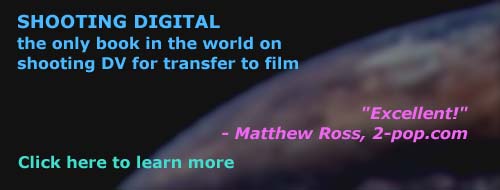
|
|
Top ten most commonly asked questions: 1. Why do I need a digital cinema package? Digital Cinema Packages are quickly becoming the standard way for theatrical distribution of movies. Many theaters in the United States and worldwide only have digital screens, especially the newer venues. Major film festivals accept DCPs for competition and even the Academy Awards requests a DCP for consideration. DCPs are very inexpensive compared to 35mm prints and never deteriorate in quality! By making a DCP, you guarantee that your movie will be able to screen in most theaters and with the best quality available. 2. How much does it cost to have my film encoded to a digital cinema package? Encoding cost $40 per minute with a 5 minute minimum for short projects. A 90 minute film would cost $3600. You can also encode the DCP yourself (see #7). 3. How long does it take to do the encoding? Two to four weeks, depending on our current workload. 4. What is the quality like? Excellent. If the source material is high-quality HD, such as DVCPROHD, then the result will look great on the big screen. 5. Do you have student discounts, or will you transfer a film for free? No, but we do offer special rates on occasion to members of our mailing list (sign up here). We also take four major credit cards, and we are the lowest-cost facility in the world offering digital cinema package encoding. 6. What camera should I buy? Right now the Panasonic HPX300 is the best choice for under $10,000, or the Panasonic HPX170 for under $5000. However any three-chip "prosumer" digital video camera, costing 3,500 dollars or more, can be used to make an excellent digital cinema package. In addition, there are the Canon DLSR cameras that shoot 1080p 24p video. 7. What editing hardware/software should I use? Our recommended editing program, which can edit your clips together and author DCP directly from your project, is Raylight Cutter. 8. What settings should I use on my camera? For 24P cameras like the HPX300, shoot 24PN with 1/50 or 1/60 sec shutter speed. Other settings may be determined by eye and with the use of a high-quality studio monitor. Don't shoot too dark or too light, try to get a solid exposure, and watch focus very carefully. 9. Can you encode from HD, Quicktime, or computer image files? Yes, see our services page. 10. Where can I see your work? At film festivals all around the country (see upcoming projects). You could have a test made from your own footage. Sign up for our mailing list to get announcements of festival screenings. 11. How do you do the transfer? You export your movie to an uncompressed file in quicktime or AVI file format and put it on a small hard drive or memory stick and send it to us. The resulting image frames are then converted by us to 24p (if they were not already shot 24P) NTSC and 23.976 projects will be sped up by .1% to 24 frames/sec, 25P projects will be slowed down 4% and the dialog rate-converted (no pitch change) if it is provided as a separate track. Then the frames are encoded to JPEG2000 2048x1080 files. For the audio we can accept a 5.1 mix in 6 separate tracks (left, right, center, left surround, right surround, subwoofer) or 4 separate tracks (left, right, center, surround), or stereo, or premixed stems (dialog in stereo or mono, stereo music, mono or stereo surround effects). The resulting DCP is presentable at any DCP compatible movie theater worldwide. If you need more information, read our more detailed FAQ which follows here, or buy Marcus van Bavel's SHOOTING DIGITAL now available for purchase by credit card though this site. Also see our Links Page. MORE QUESTIONS 12. What exaxtly do I have to provide to you for the transfer? An uncompressed quicktime 10bit 4:2:2 on a hard drive or memory stick. For the audio we can accept a 5.1 mix in 6 separate tracks (left, right, center, left surround, right surround, subwoofer) or 4 separate tracks (left, right, center, surround), or stereo, or premixed stems (dialog in stereo or mono, stereo music, mono or stereo surround effects). 13. Can I provide you with a Quicktime or frames in image file format? Yes, you can give us image files or Quicktime files. 1280H x 720V, square pixels, 24 fps or 1920H x 1080V, square pixels, 24 fps. 14. What if I shot my film at 24P? Can you drop out the "pull-down" frames. We recommend removing the pulldown and editing at true 24p. You can always add back in a pulldown if you need an NTSC copy of your final edit. For 24P projects edited on NTSC: If possible, try to avoid superimpositions, dissolves, or cuts that disturb the 5-frame cadence of the telecine conversion. We have software which will removie the 3:2 pulldown on transfer to film. For more information on 3:2 pulldown, click here. These recomendations also apply to DVX100 24P material or Canon XL-2 24P material which was edited in an NTSC timeline. 15. I need to print out information on your web site. How do I do it? We recommend you buy the book SHOOTING DIGITAL which contains all the information on this website plus a lot more. Click here to purchase by credit card. 16. Do you encode from PAL? Yes, we can encode a DCP from any PAL format. It is best for the time-expansion process from 25 to 24 fps if you provide us separate, pre-mixed, music, dialog, and sound effects tracks on CDROM. The tracks are time-expanded to 24 fps separately and then mixed together for the final track. Have an important question that is not on this FAQ? Contact us!
|
